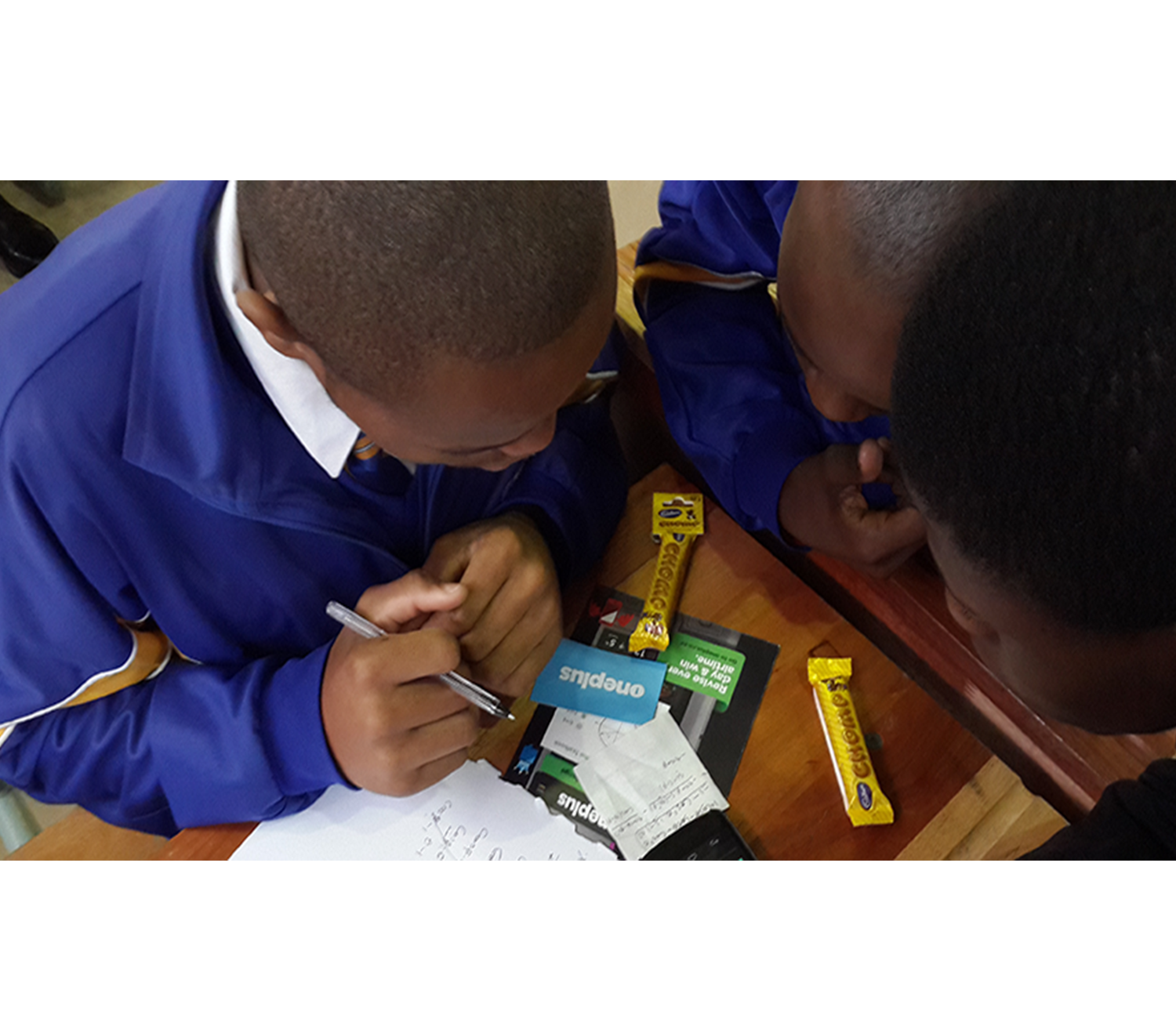Learn from others and share your own experience
EXCHANGE
What works, what looks promising, and how can programmes learn from each other? Peer-reviewed articles and case studies help build the evidence base for programming, while there are various approaches to learning and sharing knowledge.
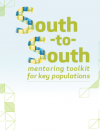 South-to-South mentoring toolkit for key populations
South-to-South mentoring toolkit for key populationsThis toolkit supports mentors from key-population-led organisations in the global South to mentor other organisations in the global South. It explains what S2S mentoring is, the mentor’s role, how to choose among different approaches, and the technical skills needed to mentor effectively.
FHI 360 LINKAGES, Pact, 2016
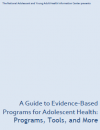 A guide to evidence-based programs for adolescent health: Programs, tools, and more
A guide to evidence-based programs for adolescent health: Programs, tools, and moreThis guide provides an annotated list of resources for effective behavioural and social interventions in adolescent health (including sexual health), with links to evidence-based practices. It also identifies implementing tools that are available from the listed resources for evidence-based practices.
National Adolescent and Young Adult Health Information Center, USA, 2014
 Locating information for HIV programs: Grey literature and open access scholarly publications
Locating information for HIV programs: Grey literature and open access scholarly publicationsThis guide gives step-by-step instructions on conducting a search of Google Advanced and Google Scholar - databases that are free to access - in order to find grey literature and open-access publications on any topic, including adolescent and young key populations and HIV.
University of Manitoba Libraries, 2018
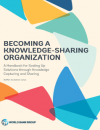 Becoming a knowledge-sharing organization: A handbook for scaling up solutions through knowledge capturing and sharing
Becoming a knowledge-sharing organization: A handbook for scaling up solutions through knowledge capturing and sharingThis is a set of guidelines on creating knowledge-sharing practices in development-sector organisations. It shows how to build an enabling environment and develop the skills needed to capture and share knowledge gained from operational experiences to improve performance and scale up successes. Areas covered include leadership, governance, budgets, and financing, and partnership. It also covers how to identify and format knowledge, how to share it, and how to use it for learning and scale-up.
World Bank Group, 2016
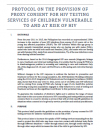 Social and structural factors increase inconsistent condom use by sex workers’ one-time and regular clients in northern Uganda
Social and structural factors increase inconsistent condom use by sex workers’ one-time and regular clients in northern UgandaStructural and interpersonal factors strongly influence inconsistent condom use by clients, with violence by clients and police, low sexual control by workers, migration, and single-parenthood all linked to non-condom use. There is a need for peer-led structural interventions that improve access to occupational health and safety standards. Shifts away from the current punitive approaches and towards sex workers are integral to the success of such interventions as they continue to undermine HIV prevention efforts.
AIDS Care Duff et al, 2018
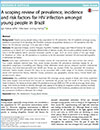 HIV risks and needs related to the Sustainable Development Goals among female sex workers who were commercially sexually exploited as children in Lesotho
HIV risks and needs related to the Sustainable Development Goals among female sex workers who were commercially sexually exploited as children in Lesotho Risk determinants for HIV and violence among sexually exploited children can be studied retrospectively through research with adult female sex workers. Further research working directly with sexually exploited children will improve understanding of their needs. Preventing commercial sexual exploitation of children and addressing the social and healthcare needs of those who are exploited are necessary to fully achieve SDGs 5, 8 and 16 and an AIDS-free generation.
Journal of the International AIDS Society Grosso et al, 2018
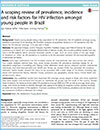 A scoping review of prevalence, incidence and risk factors for HIV infection amongst young people in Brazil
A scoping review of prevalence, incidence and risk factors for HIV infection amongst young people in BrazilFew published studies have examined HIV among young people in Brazil, and those published have been largely cross-sectional and focused on traditional risk groups and the south of the country. Despite these limitations, the literature shows raised HIV prevalence among men who have sex with men and female sex workers—as well as among those using drugs. Improved surveillance of HIV incidence, prevalence, and risk factors is a key component of efforts to eliminate HIV in Brazil.
BMC Infectious Diseases Saffier et al, 2013
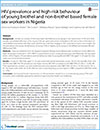 HIV prevalence and high-risk behaviour of young brothel and non-brothel based female sex workers in Nigeria
HIV prevalence and high-risk behaviour of young brothel and non-brothel based female sex workers in NigeriaExisting and future interventions on HIV prevention should focus on empowering young female sex workers with innovative and sustainable approaches aimed at improving their health and wellbeing.
BMC Research Notes Okafor et al, 2017
 Young women's perceptions of transactional sex and sexual agency: A qualitative study in the context of rural South Africa
Young women's perceptions of transactional sex and sexual agency: A qualitative study in the context of rural South AfricaTransactional sex is embedded in adolescent romantic relationships, but certain aspects make young women particularly vulnerable to HIV. This is especially true in situations of restricted choice and circumscribed employment opportunities. HIV prevention educational programmes could be coupled with income generation trainings— to leverage youth resilience and protective skills within the confines of difficult economic and social circumstances.
BMC Public Health Ranganathan et al, 2017
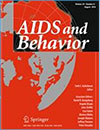 HIV-Risk Index: Development and validation of a brief risk index for Hispanic young people
HIV-Risk Index: Development and validation of a brief risk index for Hispanic young peopleThe purpose of this study was to develop and validate a risk index to assess the different sexual HIV risk exposure among Hispanic young people. The index developed seems to be a rigorous and valid measure to estimate HIV risk exposure.
AIDS and Behavior Ballester-Arnal et al, 2016
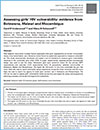 Assessing girls HIV vulnerability: Evidence from Botswana, Malawi and Mozambique
Assessing girls HIV vulnerability: Evidence from Botswana, Malawi and Mozambique This study characterized, developed and tested a set of indicators to measure girls' vulnerability to HIV, resulting in the vulnerable girls index (VGI). The VGI can be used to assess girls' vulnerability levels across time and space for policy and programme planning purposes, and as part of programme evaluations.
Health Policy and Planning Underwood et al, 2016
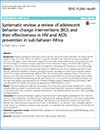 Systematic review: A review of adolescent behavior change interventions [BCI] and their effectiveness in HIV and AIDS prevention in sub-Saharan Africa
Systematic review: A review of adolescent behavior change interventions [BCI] and their effectiveness in HIV and AIDS prevention in sub-Saharan AfricaThere are mixed findings about the effectiveness of psychosocial behaviour change interventions targeting adolescents in sub-Saharan Africa. Some studies portray intervention effectiveness and others limited efficacy. Peer education as an intervention stands out as being more effective than other psychosocial regimens at transferring life skills and facilitating HIV risk reduction.
BMC Public Health Mwale et al, 2017
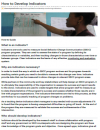 What works in youth HIV
What works in youth HIVThis website compiles emerging and evidence-based interventions for those who work with young people to prevent HIV. The areas covered are strategies, youth and HIV, and engaging youth. Resources include videos, webinars, podcasts, websites, reports, toolkits, and factsheets.
JSI, 2018
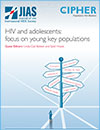 HIV and adolescents: Focus on young key populations
HIV and adolescents: Focus on young key populationsThis journal supplement contains articles addressing various aspects of HIV prevention and adolescents and young people from key populations—including PrEP, HIV testing, links to services, adherence and retention in care, and mental health and support.
Journal of the International AIDS Society, 2015
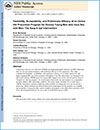 Feasibility, acceptability, and preliminary efficacy of an online HIV prevention program for diverse young men who have sex with men: The Keep It Up! intervention
Feasibility, acceptability, and preliminary efficacy of an online HIV prevention program for diverse young men who have sex with men: The Keep It Up! interventionThese are results of a trial evaluating an online, interactive HIV prevention programme in the United States called Keep It Up! The intervention was designed to be delivered to diverse young men who have sex with men (aged 18-24) after they received an HIV-negative text result—to encourage them to “Keep It Up” and stay negative.
AIDS and Behavior Mustanski et al, 2013
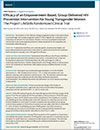 Efficacy of an empowerment-based, group-delivered HIV prevention intervention for young transgender women: The Project LifeSkills randomized clinical trial
Efficacy of an empowerment-based, group-delivered HIV prevention intervention for young transgender women: The Project LifeSkills randomized clinical trial This trial is the first to-date to demonstrate evidence of efficacy for a behavioural intervention to reduce sexual risk in young transgender women (aged 16-29 years)..
JAMA Pediatrics Garofalo et al, 2018
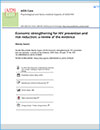 Economic strengthening for HIV prevention and risk reduction: A review of the evidence
Economic strengthening for HIV prevention and risk reduction: A review of the evidenceConditional and unconditional cash transfers, and educational support were each associated with reductions in self-reported risk behaviors, particularly among adolescents. Food assistance in combination with other support also shows a positive trend for adolescent risk reduction. Well-designed vocational/entrepreneurial training and savings interventions could bolster HIV prevention efforts for female sex workers, while findings are less conclusive for adolescents.
AIDS Care Swann, 2018
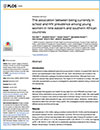 The association between being currently in school and HIV prevalence among young women in nine eastern and southern African countries
The association between being currently in school and HIV prevalence among young women in nine eastern and southern African countriesAlthough the relationship is not uniform across countries or over time, these data are supportive of the hypothesis that young women in school are at lower risk of being HIV positive than those who leave school in some sub-Saharan African settings. There is a possibility of reverse causality, with pre-existing HIV infection leading to school dropout. Further investigation of the contextual factors behind this variation will be important in interpreting the results of HIV prevention interventions promoting retention in school.
PLoS One Mee et al, 2018
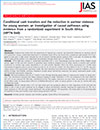 Conditional cash transfers and the reduction in partner violence for young women: An investigation of causal pathways using evidence from a randomized experiment in South Africa
Conditional cash transfers and the reduction in partner violence for young women: An investigation of causal pathways using evidence from a randomized experiment in South AfricaA conditional cash transfer for high school girls has protective effects on their experience of intimate partner violence (IPV) and the effect is due in part to girls choosing not to engage in sexual partnerships, thereby reducing the opportunity for IPV. As a lower exposure to IPV and safer sexual behaviours also protect against HIV acquisition, this study adds to the growing body of evidence on how cash transfers may reduce young women's HIV risk.
Journal of the International AIDS Society Kilburn et al, 2018
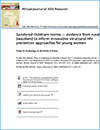 Gendered childcare norms: Evidence from rural Swaziland to inform innovative structural HIV prevention approaches for young women
Gendered childcare norms: Evidence from rural Swaziland to inform innovative structural HIV prevention approaches for young womenInnovative approaches to prevent HIV in young women should incorporate structural approaches that aim to transform gendered norms, economically empower women and implement policies guaranteeing women equal rights.
African Journal of AIDS Research Shabangu et al, 2017
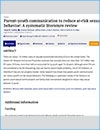 Parent–youth communication to reduce at-risk sexual behavior: A systematic literature review
Parent–youth communication to reduce at-risk sexual behavior: A systematic literature reviewSome research has shown that parent–youth communication can reduce youth’s at-risk sexual behaviors. This is a systematic review of the literature on parent–youth sexual communication and family-level interventions designed to reduce risky sexual behavior in youth.
Journal of Human Behavior in the Social Environment Coakley et al, 2017
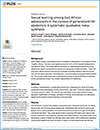 Sexual learning among East African adolescents in the context of generalized HIV epidemics: A systematic qualitative meta-synthesis The three phases of sexual learning – being primed for sex, making sense of sex, and having sexual experiences – interact to shape adolescents' sexual lives and their risk for HIV infection. This framework will contribute to the development of sexual education programmes that address HIV risk within the broader context of sexual learning.
Sexual learning among East African adolescents in the context of generalized HIV epidemics: A systematic qualitative meta-synthesis The three phases of sexual learning – being primed for sex, making sense of sex, and having sexual experiences – interact to shape adolescents' sexual lives and their risk for HIV infection. This framework will contribute to the development of sexual education programmes that address HIV risk within the broader context of sexual learning.PLoS One Knopf et al, 2018
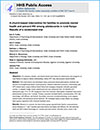 A church-based intervention for families to promote mental health and prevent HIV among adolescents in rural Kenya: Results of a randomized trial
A church-based intervention for families to promote mental health and prevent HIV among adolescents in rural Kenya: Results of a randomized trialThis intervention holds promise for strengthening positive family processes to protect against negative future outcomes for adolescents. Implementation with religious congregations may be a promising strategy for improving sustainability and scalability of interventions in low-resource settings.
Journal of Consulting and Clinical Psychology Puffer et al, 2016
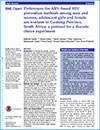 Preferences for ARV-based HIV prevention methods among men and women, adolescent girls and female sex workers in Gauteng Province, South Africa: A protocol for a discrete choice experiment
Preferences for ARV-based HIV prevention methods among men and women, adolescent girls and female sex workers in Gauteng Province, South Africa: A protocol for a discrete choice experiment This study will explore potential users' preferences regarding HIV prevention products; quantify the importance of product attributes; and predict the uptake of products to inform estimates of their potential impact on the HIV epidemic in South Africa. We consider preferences for oral pre-exposure prophylaxis; a vaginal microbicide gel; a long-acting vaginal ring; a SILCS diaphragm used in concert with gel; and a long-acting ARV-based injectable.
BMJ Open Quaife et al, 2018
 A smartphone game-based intervention (Tumaini) to prevent HIV among young Africans: Pilot randomized controlled trial
A smartphone game-based intervention (Tumaini) to prevent HIV among young Africans: Pilot randomized controlled trialIf proven efficacious, smartphone games have the potential to dramatically increase the reach of culturally adapted behavioral interventions while ensuring fidelity to intervention design.
JMIR mHealth and uHealth Winskell et al, 2018
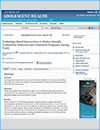 Technology-based interventions to reduce sexually transmitted infections and unintended pregnancy among youth
Technology-based interventions to reduce sexually transmitted infections and unintended pregnancy among youthAfter 15 years of research on youth-focused technology-based interventions, this meta-analysis demonstrates their promise to improve safer sex behavior and cognitions. Future work should adapt interventions to extend their protective effects over time.
Journal of Adolescent Health Widman et al, 2018
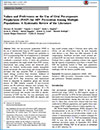 Values and preferences on the use of oral pre-exposure prophylaxis (PrEP) for HIV prevention among multiple populations
Values and preferences on the use of oral pre-exposure prophylaxis (PrEP) for HIV prevention among multiple populationsFindings from a rapidly expanding evidence base suggest that the majority of populations most likely to benefit from PrEP feel positively towards it. These same populations would benefit from overcoming current implementation challenges with the shortest possible delay.
AIDS and Behavior Koechlin et al, 2017
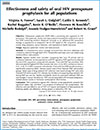 Effectiveness and safety of oral HIV preexposure prophylaxis for all populations
Effectiveness and safety of oral HIV preexposure prophylaxis for all populationsPrEP is protective against HIV infection across populations, presents few significant safety risks, and there is no evidence of behavioral risk compensation. The effective and cost-effective use of PrEP will require development of best practices for fostering uptake and adherence among people at substantial HIV risk.
AIDS Fonner et al, 2016
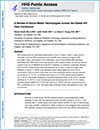 A review of social media technologies across the global HIV care continuum
A review of social media technologies across the global HIV care continuumSocial media is immensely popular and is increasingly being used as a tool in HIV research. However, the use of SM to address issues along the HIV care continuum remains an under-researched topic, especially in regard to the various different combinations of SM platforms and interventions. There is an even greater need for statistically rigorous studies on efficacy, effectiveness, and long-term effects.
Current Opinion in Psychology Garett et al, 2016
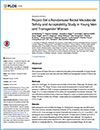 Project gel a randomized rectal microbicide safety and acceptability study in young men and transgender women
Project gel a randomized rectal microbicide safety and acceptability study in young men and transgender womenThis study enrolled a sexually active population of young men who have sex with men and transgender women who were willing to use rectal microbicides. TFV gel was safe and acceptable and should be further developed as an alternative HIV prevention intervention for this population.
PLoS One McGowan et al, 2016
This tool maps the available evidence about the use of information and communication technology (eHealth) to improve HIV prevention, diagnosis, treatment and care for key populations and young people. It provides abstracts of journal articles that can be filtered by country, region, date, target group, study design and effectiveness.
International HIV/AIDS Alliance, 2018
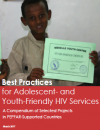 Best practices for adolescent- and youth-friendly HIV services
Best practices for adolescent- and youth-friendly HIV servicesThis compendium of selected projects in PEPFAR-supported countries details seven best practices, four promising practices, and two emerging practices in adolescent- and youth-friendly HIV services in African countries and in the Dominican Republic. These include interventions that are clinic-based, clinic- and school-based, community-based, and mobile and web-based.
USAID, PEPFAR, Measure Evaluation, 2017
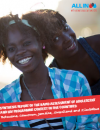 Synthesis report of the rapid assessment of adolescent and HIV programme context in five countries: Botswana, Cameroon, Jamaica, Swaziland and Zimbabwe [ALL IN Initiative]
Synthesis report of the rapid assessment of adolescent and HIV programme context in five countries: Botswana, Cameroon, Jamaica, Swaziland and Zimbabwe [ALL IN Initiative]This report introduces the ALL IN agenda to end adolescent AIDS, and describes the methods, process and main findings of rapid, data-driven assessments conducted in five countries. It offers cross-cutting recommendations for programmes.
UNICEF, 2018
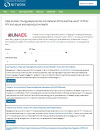 Case studies: Young people across sub-Saharan Africa and the use of ICTs for HIV and sexual and reproductive health
Case studies: Young people across sub-Saharan Africa and the use of ICTs for HIV and sexual and reproductive healthThis compendium of 13 case studies focuses on young people across sub-Saharan Africa and the use of information and communication technologies (ICTs) for HIV and sexual and reproductive health programming. It includes full technical details on a range of ICT-relevant software and content
C4D, 2018
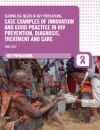 Serving the needs of key populations: Case examples of innovation and good practice in HIV prevention, diagnosis, treatment and care
Serving the needs of key populations: Case examples of innovation and good practice in HIV prevention, diagnosis, treatment and careExamples of innovative programmes around the world that seek to increase access to vital health and supportive services for key populations and to protect their rights.
WHO, 2016
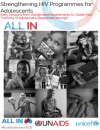 Strengthening HIV programmes for adolescents: Early lessons from adolescent assessments to guide fast tracking of adolescent responses through ALL IN
Strengthening HIV programmes for adolescents: Early lessons from adolescent assessments to guide fast tracking of adolescent responses through ALL INThis is a 2015-2016 report on assessments conducted in countries involved in the ALL IN initiative to strengthen national responses to HIV in adolescents. The report summarizes programme impacts, policy impacts, resource mobilisation, and the influence of the initiative on leadership, advocacy, and national and regional agendas.
UNICEF, UNAIDS , 2016
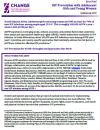 HIV prevention with adolescent girls and young women: Data brief
HIV prevention with adolescent girls and young women: Data briefThis is an analysis of the PEPFAR DREAMS Partnership to prevent new HIV infections among adolescent girls and young women, with information on strategies and approaches that work, and ones that do not.
Center for Health and Gender Equity, 2018
